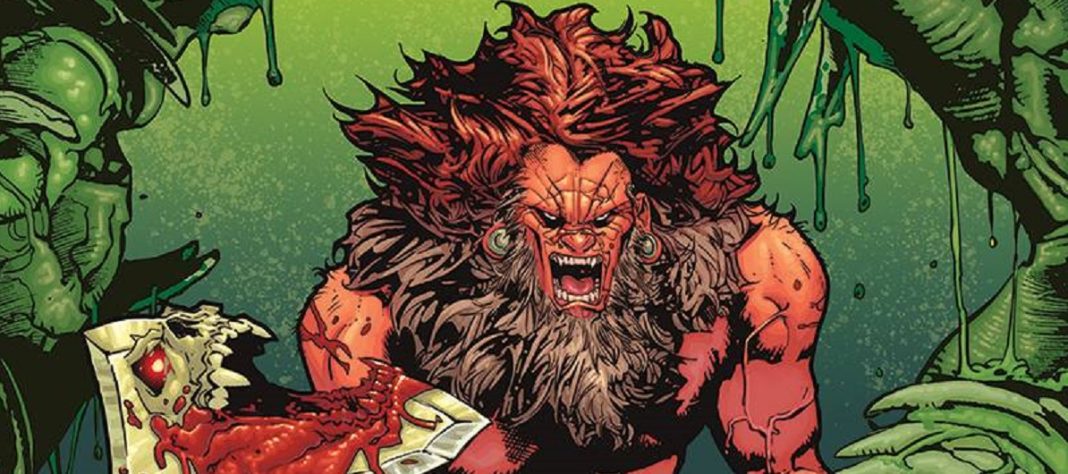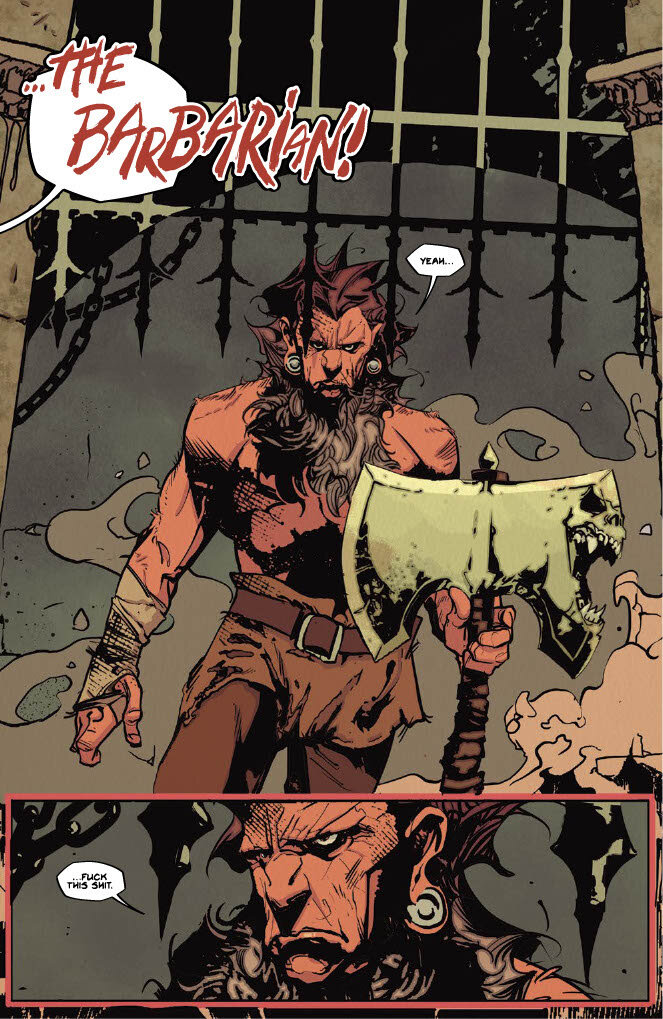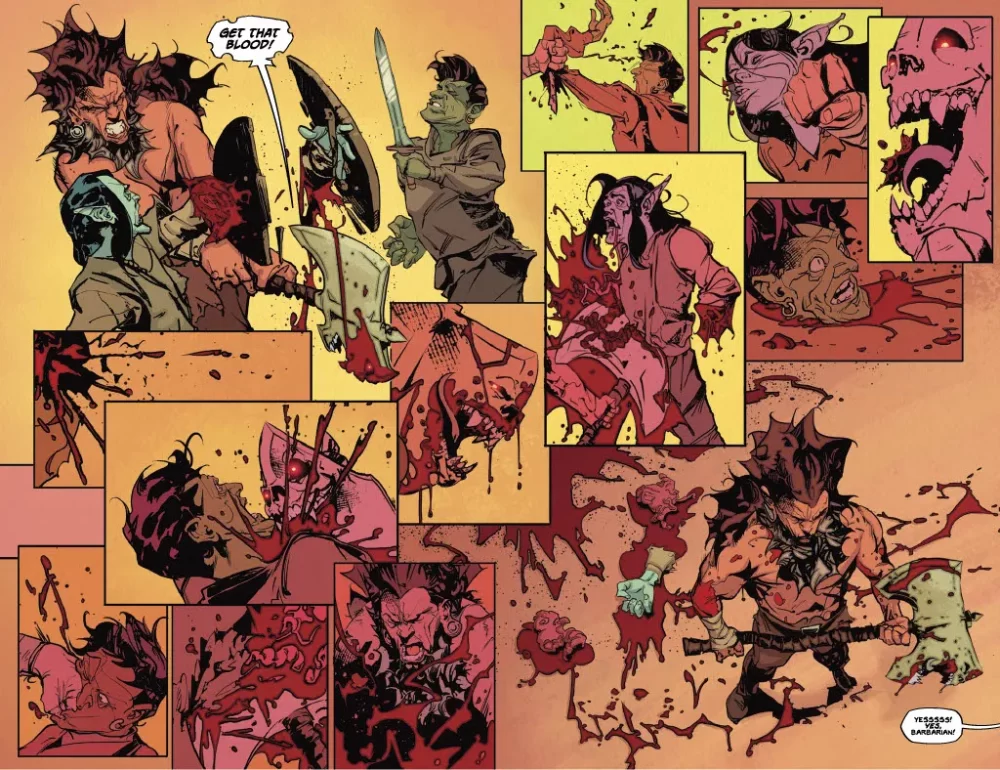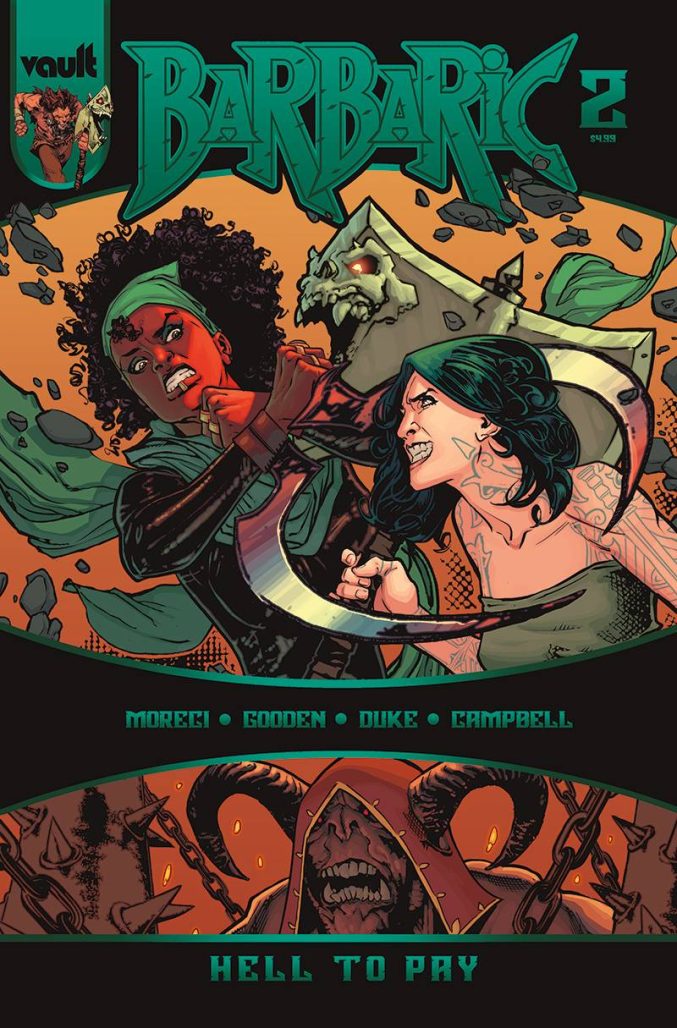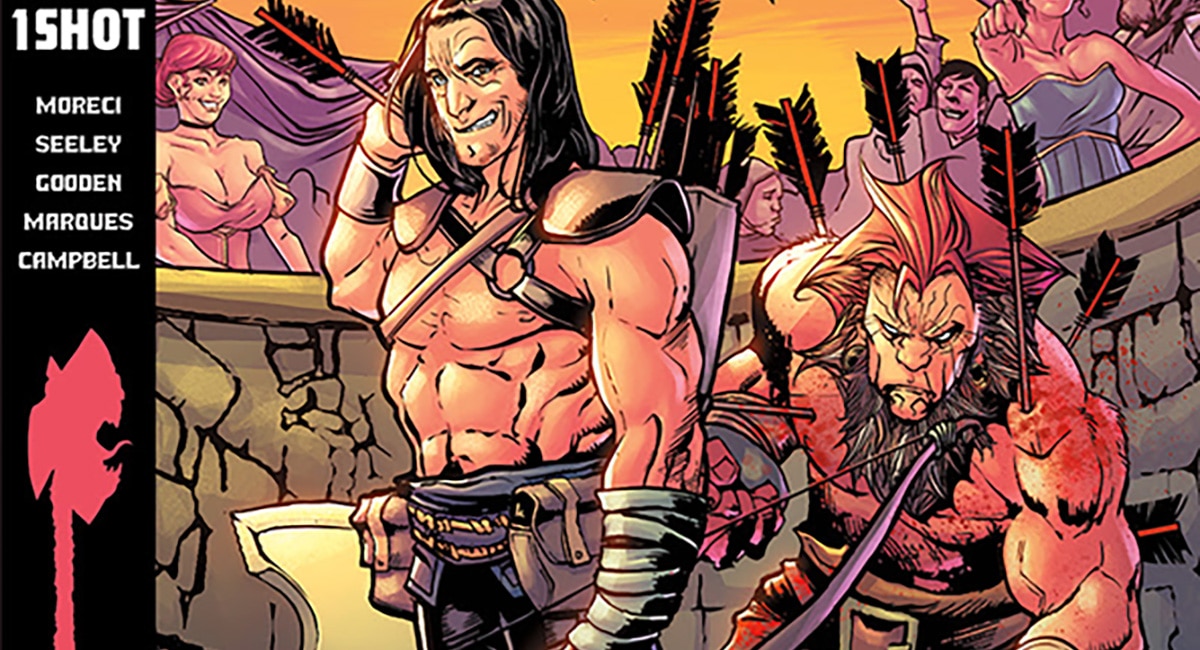The simple — if sad — truth of indie comics is that most of them fail.
That doesn’t mean they are bad, necessarily. But I’ve been writing about indie comics for five years now, and I’ve read a lot of good books. Hell, great books even. Yet, the majority of them are basically dead on arrival in the current market, cluttered and chaotic as it is, with too many books for too few readers, all of whom have never had so many non-comics entertainment options.
As a result, a second arc often feels like a gift; while a sustained run with double digit issues and a hardcover? Well, that feels like a miracle. But a genuine smash hit monthly book recently exploded into comics book stores — 2021’s Barbaric from writer Michael Moreci, artist Nathan Gooden, colorist Addison Duke, and letterer Jim Campbell (published by Vault).
The premise of Barbaric is, in a word, awesome. Owen is a barbarian with a curse that requires him to do good. Owen has a talking axe (complete with face), and that axe gets drunk on the blood of unrighteous foes it slaughters. Not just drunk, straight-up hammered. Add friends — a witch, Soren, and a vampire, Steel — and voila — Barbaric, a raucous and clever hangout comic, punctuated with giant bursts of gritty and kinetic action cartooning.
Barbaric is basically all you want from a direct market book, and, thankfully, it has found a sizable audience. In fact, it’s on its third miniseries, and Vault has even declared this Year of Axe, anchoring its 2023 line to the book. Barbaric is expanding, launching new minis and one-shots, and bringing in big name guest creators (fantasy novelist Nicholas Eames, among them).
So, I caught up with writer Michael Moreci to talk all things Barbaric, and my first question was right to the point — what does it feel like to have a hit indie comic?
How does it feel to write a hit indie comic?
The obvious answer is it feels great to write a hit indie comic. Why wouldn’t it? But Moreci told me that when he thinks about Barbaric’s success, he mostly thinks about timing. Specifically, the timing within the context of his career, dating back to when he started writing indie comics with 2014’s Roche Limit, which was published by Image.
“I don’t know if I would have crafted or handled Barbaric the same way I did at its inception two or three years ago, the way I would have 10 years ago or six years ago,” Moreci said. “It’s funny. It’s such a wild book, but there’s also a lot of mindfulness of what I wanted to do with the book, and how I wanted to position it.”
And lot of those mindful choices were informed by Moreci’s past work on other projects in the indie market.
“I don’t want to make it seem like I wrote it specifically for the marketplace,” he said, “but in my mind, I was like, ‘what will help?’ It’s so hard to make a hit indie comic. It’s so hard not only to get eyeballs to an indie project — and indie is where I exist, and I can’t imagine I will ever not exist — but it’s hard to get it to sustain. A lot of thought went into what is the stuff that’s eye grabbing: iconography, comics as an art form and medium itself. What are the things that will help with its longevity? Like the miniseries format, or the Hellboy format, you could say.
So, it feels great, but when I step back and look at it — I’m aware of the decisions I made with this comic that I wouldn’t have made before. It’s the process of growing up in comics. As immature as Barbaric is, [laughs] it’s also the process of me growing up a little bit and being more mindful of what I’m doing.”
Working With Artist Nathan Gooden
The successful development of the book, of course, is also due in no small part to artist Nathan Gooden, Moreci’s co-creator. Gooden has long been one of my favorite artists in direct market indie comics, dating back to 2017’s Zojaqan (my first exposure to his work as well as to Vault Comics, period, and a great window into all that the publisher aspired to become, but that’s another column…).
Gooden, who is Vault Comics’ art director, has been an integral part of the publisher rising into one of the buzziest and most respected in the indie space. In between Zojaqan and Barbaric, Gooden drew among other things the original graphic novel, Brandon Sanderson’s Dark One. That fantasy story — crafted for the book market — drew from similar aesthetics as does Barbaric, and while I absolutely loved that book, it is in part a predecessor of Barbaric, in that I’m not sure Gooden’s work (colored by Addison Duke) is as finely honed in the latter without the former.
Getting back to the idea of timing, it also played a role in the strength of the collaboration between Moreci and Gooden.
“He’s so good, he’s so tremendous,” Moreci said of his co-creator, “and I’m mindful in my script about what cool stuff can I give Nate to draw. He contributes to that as well, because he gives me good ideas and says what about this, or let’s explore that, and they’re always great ideas. They find their way into each issue no matter what.
Again, it’s a maturity thing. I think I learned a lot of that from Hayden [Sherman] on Wasted Space. As a writer, you get so lost in the things that call attention to you as a writer, like how well-written the script is, when sometimes you can say, ‘Hey Hayden, they’re going into this vortex and this crazy stuff is going to happen to Molly, see what happens on the page.’ Or, ‘Hey Nate, Owen and Ax are just going to obliterate a bunch of orcs. Go for it. Here’s two pages.’ Great things happen, and you don’t need to build too much into that; that’s what comics are for.”
Did the team expect Barbaric to be a hit?
The team knew the book felt exciting to them, but they also knew better than to expect guaranteed success. When I asked Moreci if he thought it was going to be well-received, he wasn’t entirely sure.
But he knew one thing.
“Look, I’ll tell you what — you know when you don’t have a hit. You read a first issue — and I’ve had this happen to me, I won’t name it — with one comic. You just know, this is not what I thought it would be. There’s no real person to blame, but you just know. Or you have a feeling like, I don’t know, let’s see what happens when this gets released.
But with Barbaric, we knew to a degree. So, Nate and I really created this together in a really organic sense. From the inception, we really talked things out and worked things out a lot. We developed Ax really closely together. It was a sword, then it was a shield — we just figured this stuff out. We figured out what we wanted this to be, and the tone of what we wanted to be, and how we didn’t want to tie ourselves down to a narrative you see all the time in comics.
As we were working on this and getting excited and figuring stuff out, we were like, ‘This is really good, this is really becoming something.’ And yeah, I think we were confident that this has a chance, this has a good chance. Now, where it launched and where it’s gone since, I would have never predicted.”
The numbers for Barbaric have been strong, and, more importantly, sustaining. Initially, the book wasn’t even planned as a periodical comic. The vibrant fluidity of the creative process and the strong early response, led the team to make some changes.
“There were really two retoolings that we did, ” Moreci said. “Originally, Barbaric was just going to be an OGN. It was during the pandemic we really started taking off with this, and we thought, let’s just put out a complete story for people. We thought it would do well given how crazy things were with the market, but then as it started coming together, we thought, ‘Wow, there’s something happening with this book creatively.’ Vault said this was a direct market book, and we need to cut it up into issues. I had the OGN written, and I had to go and cut it up into issues. That’s how it become three issues. I wrote 90 pages, and I had to slice it up and put in the cliffhangers.
The second retooling was either after the first issue came out, or when we got the first issue numbers and we saw how big it was. We went back. Barbaric #3 had a different ending. It didn’t have Steel. There was nothing there really. So we went back. I retooled what was there and Nate redrew a page and a half, something like that. We brought in Steel and the cliffhanger to go into the second volume.”
What’s next for Barbaric?
The third volume continues today with a new issue, Barbaric: Axe to Grind #2. That’s just the start though. Later this year there will be two new miniseries, which will expand the world of the story and also add up to something bigger, which Moreci cautiously described as an event.

For his part, he said he’s trying to enjoy the moment. A writing career is filled with ups and downs, and it’s important to take stock of the good times.
“I get so many messages about this book and so much great feedback,” he said. “I’m not trying to boast, but this really has never happened to me before, not with Wasted Space, Roche Limit, whatever.
There are so many books that deserve so much better than they got. So, when you have something that breaks through like Barbaric, you can only look back and feel the gratitude for it, because you know it’s kind of rare air.”
Barbaric Vol. 1: Murderable Offenses is available now in hardcover. Barbaric: Hell to Pay #2 is out today in comic book stores.


